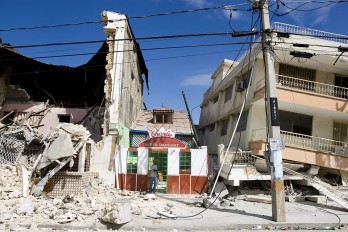Sensors installed in Ottawa area to warn people of earthquakes

Ottawa residents will one day receive a three- to 10-second advance warning of an earthquake before the ground starts shaking.
Natural Resources Canada has been installing seismic sensors in the capital region over the past week that are part of the Earthquake Early Warning Network, designed to send out a notification through electronic devices before the strong shaking from the earthquake begins.
"What that does is it gives people the time to drop, cover and hold on, so that they can be prepared just before they start feeling that shaking," said Chris Boucher, Seismic Analyst with Natural Resources Canada.
The Earthquake Early Warning Network will have 400 sensors installed in areas of increased earthquake risk across Canada, including eastern Ontario. Boucher says the seismic sensors will detect the primary (compression) P-waves of an earthquake, which are very weak, and then send out the alert.
"So these network of stations, what it does is it quickly digitizes that information, sends it to our data centres, calculates the location and the magnitude of that earthquake and if it reaches a certain threshold of shaking, it will send out alerts to cellphones, TVs and radios before that secondary (shear) S-waves and strong shaking starts," Boucher told.
In June 2010, a magnitude 5 earthquake in Val-des-Bois, caused damage in parts of western Quebec, while rattling buildings and windows in downtown Ottawa. Natural Resources Canada says the Earthquake Early Warning Network would have given residents a three to ten second warning for that earthquake.
Boucher says while a three to ten-second warning may not seem like a lot of time, it's enough time to make a difference.
“Sometimes that few seconds is all we really need to take those few steps of drop, hovering and holding on," Boucher said. "One thing to consider is that these automatic alerts would be going out to critical infrastructure, who can have automatic infrastructure in place.”
Boucher says a three to ten second warning would be enough time to divert planes from landing at airports, close bridges and tunnels to traffic and pause surgeries in hospital operating rooms.
“Once the shaking starts these systems are ready.” Natural Resources Canada says the further you are from the epicenter of the quake, the more warning time you will have.
Ottawa is part of the western Quebec seismic zone. Boucher says the region sees about 120 earthquakes a year, but only 10 or so are felt by people.
Seven seismic sensors have been installed in the Ottawa-Gatineau region so far, with plans for another twenty. Natural Resources Canada says the Earthquake Early Warning System sensors have been set up in several locations, including Cumberland, Stittsville, Mississippi Mills, Kenmore and Carsonby. One has been installed in Kingston.
The Earthquake Warning System Network is scheduled to be operational in 2024.
Sources: ottawa.ctvnews.ca, ottawacitizen.com
Want to read more like this story?

Greece and Italy: an earthquake early warning system could save lives
Feb, 08, 2022 | NewsA public earthquake early warning system in Greece and Italy could give people vital seconds’ notic...

Low-cost community-based earthquake warning system under development in New Zealand
Apr, 16, 2021 | NewsA ground-braking, low-cost, earthquake early-warning system is being developed in New Zealand. T...

5.8-magnitude earthquake strikes Ecuador coast: damaged buildings, huge loss of property, no tsunami
Mar, 28, 2022 | NewsA huge loss of property was suffered when an earthquake of magnitude 5.8 struck Ecuador coast on Sa...

Earthquakes: five deadliest earthquakes ever recorded around the world
Feb, 24, 2022 | NewsEarthquakes are one of the most dangerous natural disasters. More than 100 earthquakes of the magni...
Earthquake Engineering
Jan, 01, 2019 | EducationEarthquake engineering is a critical field of civil engineering that focuses on the analysis, desi...

UC Berkeley Advance Warning System Performed Well During Earthquake
Sep, 08, 2014 | NewsAn earthquake-detection system developed by the University of California Berkeley’s Seismological La...

Messina earthquake (1908): a civil engineering landmark
May, 26, 2023 | EducationThe 1908 Messina earthquake, also known as the Great Reggio earthquake, is considered as one of t...

The first earthquake risk model for the whole of Europe shows the cities and regions most threatened by disaster
Apr, 28, 2022 | NewsScientists have created the first earthquake risk model for Europe which will form the basis for mi...

Iran: 425 earthquakes struck in one month
Mar, 13, 2024 | NewsAccording to the seismological networks of the Institute of Geophysics at the University of Tehran,...
Trending

Spectacular interchanges around the world

New Release - STAAD.Pro 2024 - 2

ADINA 2025 for Structural WorkSuite

ADINA 2025 New Release!

Concrete Buildings as Rechargeable Batteries

Powerful earthquake shakes central Philippines, dozens killed

Indonesia school collapse: three fatalities and dozens injured

